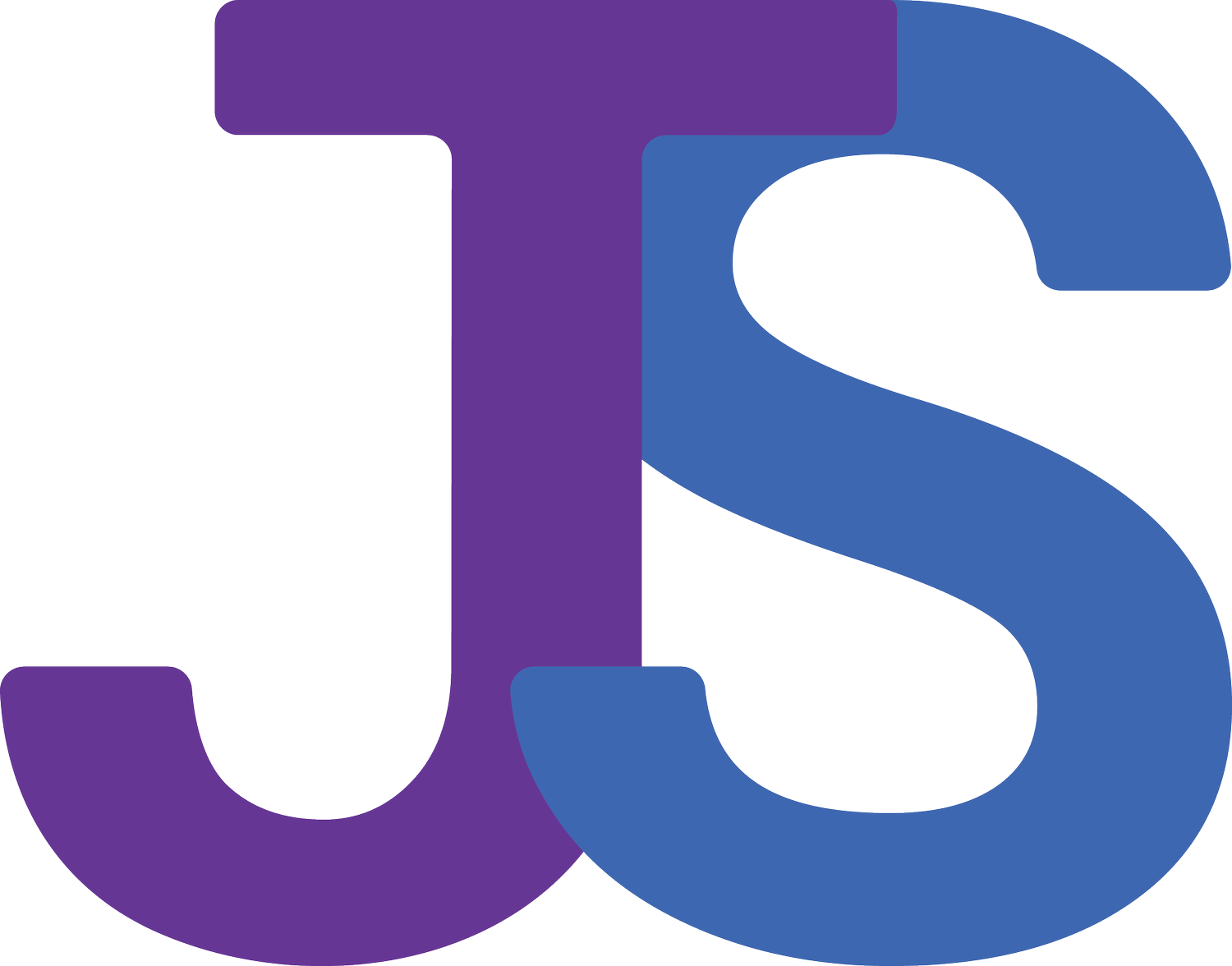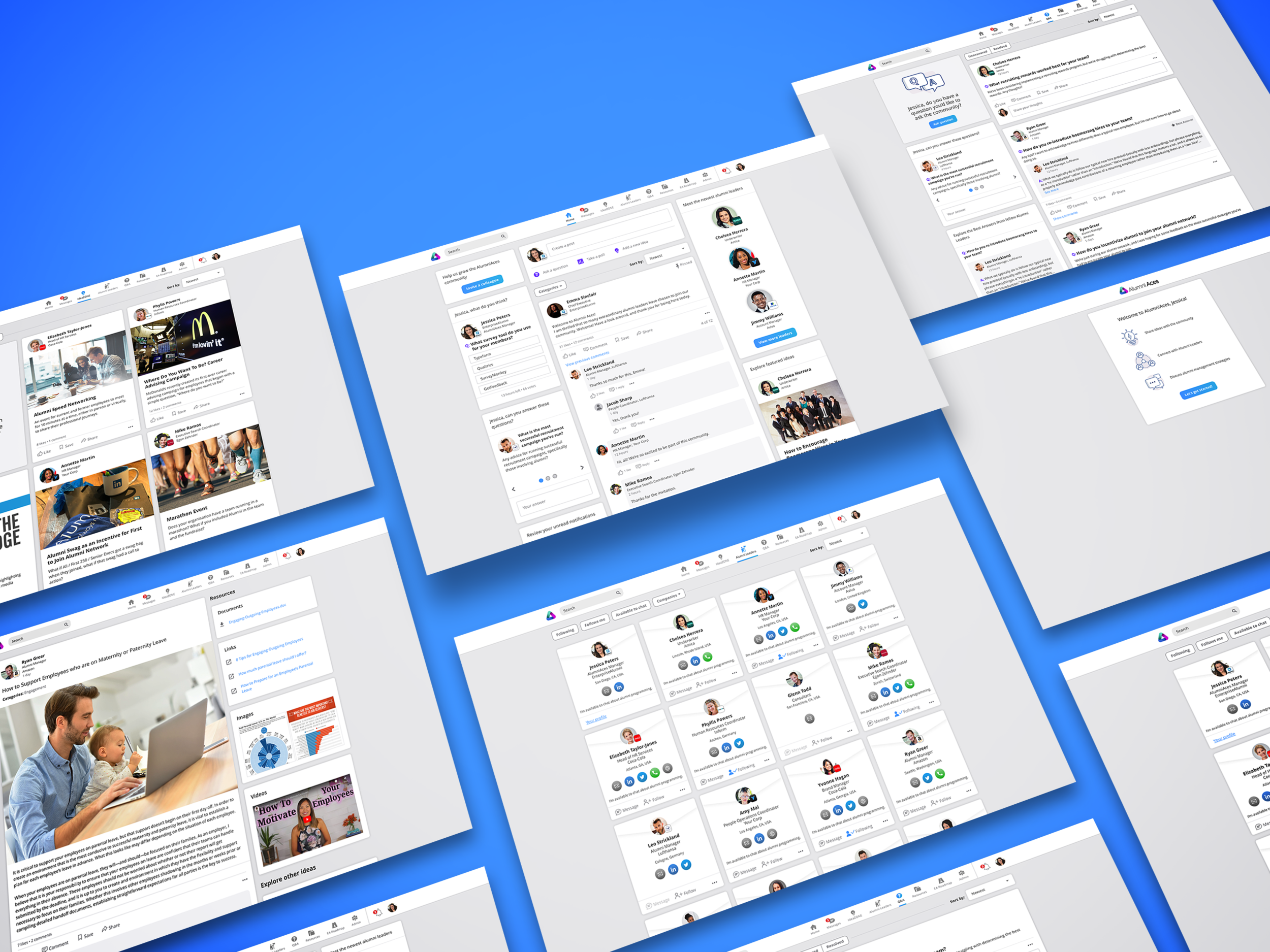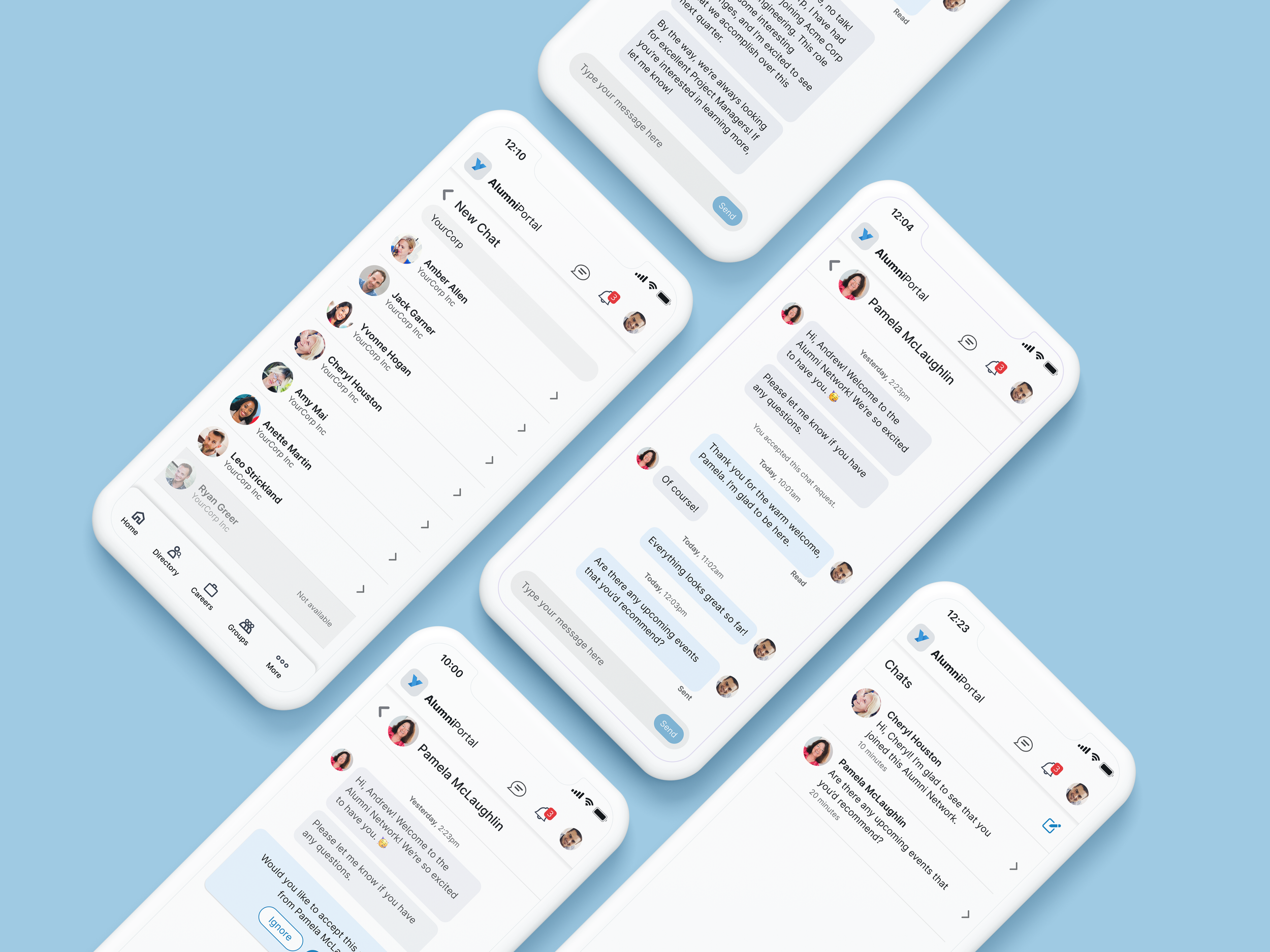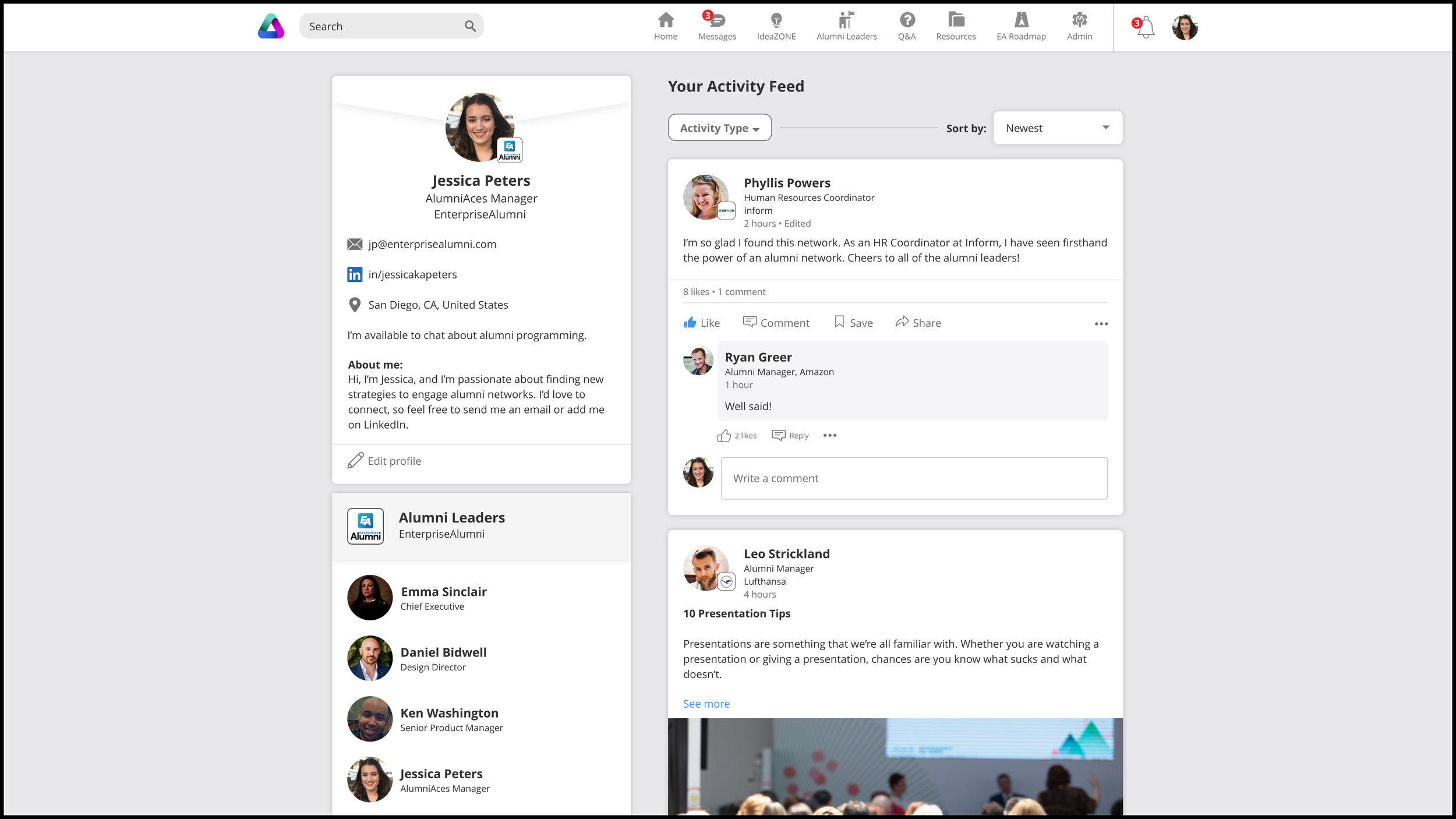Corporate Network for Alumni Management Professionals
Key Accomplishment
Owned end-to-end design process for corporate leaders network, successfully launched within a tight 6-month deadline, and attracted users from 50+ Fortune 500 companies, including IBM, P&G, and BlackRock.
Primary Team
UI/UX Designer, Product Manager, Front-End Developer
Timeline
6 months before launch | 12 months following launch
Introduction
EnterpriseAlumni is powering the alumni networks of the world’s largest organizations. My initial project at EnterpriseAlumni was to design and ultimately manage AlumniAces: a virtual community for corporate leaders who run their own alumni programs. I began working on AlumniAces my second month at EnterpriseAlumni. Over the next six months, I focused on designing the minimum viable product and overseeing initial development.
Following launch, I continued to iterate and improve the user interface and experience, perform extensive quality assurance testing, maintain the product roadmap, and manage agile sprints.
I served as the product owner and designed 95% of the user experience. AlumniAces was built by a Developer, who I worked closely with, and his team. I was advised by a Product Manager and the Design Director.
Business Goals
Due to its many competing priorities and the scrutiny it faces from external stakeholders, the existing EnterpriseAlumni platform had features on its roadmap that were out of scope.
On the other hand, AlumniAces was a skunkworks project: a project developed by a small (but mighty!) group of people with the goal of radical innovation. Since we were building a new product from the ground up, there were no dependencies on legacy systems or existing infrastructure. As a result, despite our limited resources, we had the autonomy and flexibility to experiment.
Consequently, we were able to gather requirements and review user experiences on a smaller scale, which allowed us to build new features that would have been difficult to implement on a more established platform. After I built proofs of concept for these features on AlumniAces, I shared my findings with the larger team, and together we were able to apply what I learned to EnterpriseAlumni.
From the business perspective, AlumniAces satisfied three goals:
Provide corporate alumni leaders with resources to build their alumni programs (including specific information about the EnterpriseAlumni platform)
Serve as a sales tool for prospective customers
Allow the EnterpriseAlumni team to experiment with new features
CURRENT DESIGN SOLUTION:
Home
Uses can visit the home page of AlumniAces to create a post, ask a question, take a poll, or add a new idea. They’ll also see a newsfeed featuring recent and pinned pieces of content from the community.
In the left and right columns, users can explore a variety of tiles including an introduction to the newest alumni leaders, the opportunity to vote on an ongoing poll, and a list of their unread notifications.
Check out this video to see an interactive prototype of the home page.
Design Process
For an in-depth review of my design process for specific pages, check-out: IdeaZONE, Q&A, Alumni Leaders, and Registration.
Review wireframes of a few pages below.
Home Page Wireframe
IdeaZONE Wireframe
Idea Page Wireframe
Alumni Leaders Wireframe
User Profile Wireframe
Edit User Profile Wireframe
Project Management
Since AlumniAces was a scrappy project with limited resources, I took on responsibilities that are outside the typical scope for a designer. As part of this effort, I led:
User experience and design
Development of business requirements and product roadmap
Delivery to engineering
Quality assurance testing
Regular cadence calls for agile iterations and improvements
Communication to stakeholders on progress, risks, and areas to de-scope to increase speed of deliverability
Through my ownership, six months after I began designing, AlumniAces officially launched!
“If you are not embarrassed by the first version of your product, you’ve launched too late.”
— Reid Hoffman
User Research
AlumniAces provided EnterpriseAlumni with a platform to experiment with new features. Since the majority of AlumniAces users were existing EA customers, they were eager to participate and offer feedback on the platform.
The primary tool I utilized was FullStory, a digital experience intelligence platform. I reviewed hundreds of hours of recorded footage from consenting users via FullStory’s Session Replay feature. This provided me with qualitative data and allowed me to identify user pain points such as confusing navigation or difficulty finding information.
Based on my findings, I reported bugs and proposed new features to address user needs. These insights also informed adjustments to the product roadmap, ensuring that AlumniAces continued to meet the evolving needs of its users. Thanks to the participation of EA customers and the insights gained through FullStory, I was able to continually improve AlumniAces.
Reviewing Feedback & Iterating
EnterpriseAlumni holds quarterly webinars with their alumni administrators to keep them abreast of product updates. Throughout this project, I regularly presented AlumniAces at these webinars, which was a great opportunity to hone my skill for presenting a design to non-designers, introduce the platform to more users, and receive feedback from attendees. I also held additional calls with those who requested more information.
As an additional means to receive suggestions, I included an option within the platform for users to provide feedback directly on the home page. This provided all users with an avenue to share their thoughts with me and my team.
As I continued iterating and improving AlumniAces, I refined the design to address all of the insights that came to light from this user feedback.
“The only kind of writing is rewriting.”
— Ernest Hemingway
“Designing is redesigning.”
— Jessica Stokes
Features and Functionality
Just as quickly as I checked items off of my to-do list, I continued to add new tasks as a result of continued research and reviewing user feedback. I continued expanding the capabilities of AlumniAces as well as improving how users could interact with the platform.
Over the eighteen months that I worked on AlumniAces, it grew to be a robust platform where users could perform a wide variety of actions.
Depending on their user role, users have different permissions:
All Users: Anyone in the greater alumni community can join AlumniAces, but they will have limited access.
EnterpriseAlumni Network Admins: EnterpriseAlumni customers who actively manage an alumni network receive additional options to access confidential EA information.
EnterpriseAlumni Employees: EA employees serve as administrators for AlumniAces, which necessitates extra permissions.
All Users have the ability to…
Directly message other Alumni Leaders
Opt in or out of messaging and adjust their messaging settings
Set their preferences for 12 notifications
Update their privacy settings for what is shown on their activity feeds
Request to change the company they are associated with
Add and edit posts, ideas, questions, and polls
Comment on all content types and vote on polls
Edit the information shown on their user profiles
Invite colleagues to join AlumniAces
Submit feedback and suggestions
EnterpriseAlumni Network Admins also have the ability to…
Review the EnterpriseAlumni roadmap and provide feedback
Access the “Resources” section, which includes information about launching and maintaining an EnterpriseAlumni platform
EnterpriseAlumni Employees also have the ability to…
Approve or reject membership requests
Approve or reject user requests to change their company
Pre-approve new users and input their registration information in advance
Add pre-approved domains so users with those domains are automatically approved
Adjust settings for new and existing companies
Set up webhooks to trigger internal Slack notifications for defined events
Edit transactional emails, such as the automatic email a user receives when their account is approved
Add and edit content in the “Resources” section
Review feedback submitted by users
Messaging Feature
AlumniAces allowed the EnterpriseAlumni team to experiment with new features. I initially designed peer-to-peer messaging for AlumniAces, and I later re-purposed this design for EnterpriseAlumni’s main platform, AlumniPortal.
AlumniAces Today
For about another year following launch, I continued to iterate and improve AlumniAces. Once EnterpriseAlumni’s long-term roadmap was evaluated, it was determined that AlumniAces would not be a priority moving forward.
All new customers who sign with EnterpriseAlumni are granted membership to AlumniAces as part of their onboarding process. This ensures that all of these corporate leaders will have access to a wealth of information and resources for launching their alumni platforms.
Additionally, prospective customers are granted membership to AlumniAces to give them more information about EnterpriseAlumni and how the platform has benefited existing customers.
CURRENT DESIGN SOLUTION:
User Profile
When a user views their own profile page, they’ll see their contact information, how to edit that information, and a list of fellow Alumni Leaders at their company.
In the right column, users will see a feed of all of the posts they’ve interacted with. They can filter this feed by activity type (posts, likes, comments, replies, saved, etc.) and sort accordingly.
Reflection
Reflecting on my time working on AlumniAces, I feel a deep sense of pride and gratitude. Having the opportunity to take ownership of this product so early in my design career exposed me to a multitude of challenges and responsibilities.
Through wearing multiple hats including leading cadence calls, performing quality assurance testing, and managing agile sprints, I developed a diverse set of skills and gained a comprehensive understanding of all stages of the software development lifecycle. These varied experiences allowed me to become a more well-rounded designer, equipped with the knowledge and expertise to tackle a broad range of design challenges.
Throughout the design process, I made sure to incorporate user feedback at every stage. This allowed me to iterate and improve the product based on user needs and behaviors, resulting in a more user-friendly and intuitive experience.
Overall, working on AlumniAces was an incredibly rewarding experience that taught me invaluable lessons about design, collaboration, and communication. I am proud of the product that I designed, and I know that the knowledge and skills I acquired while working on AlumniAces will benefit me for years to come.
Dive deeper into AlumniAces
◆
Dive deeper into AlumniAces ◆














